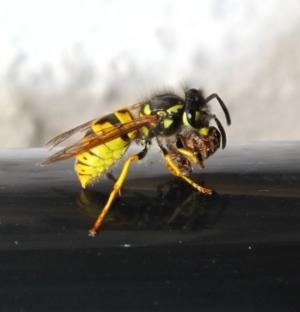
Photo ©2015 - A. Gomez
Click photo for a larger image
German Wasp - Vespula germanica
Family - Vespidae

Photo ©2015 - A. Gomez
Click photo for a larger image
This species can sting.
One of the two common species of wasp found in the British Isles, although several other species have been reported in recent years, they can be found throughout Europe. This species has been accidentally introduced into Australia, New Zealand, Africa, North America and Argentina. At 13–20mm (0.5–0.8in) long they are slightly larger than the Common Wasp – Vespula vulgaris. There are subtle differences in size and body formation between males and females as listed –
They are a very familiar black and yellow striped colouring, usually eliciting fear amongst most people, they usually only sting if provoked. They have several (5) black "shield" shaped patterns running down the back of the abdomen, whereas the Common Wasp has an inverted "crown" patterning (usually 3).
A relatively commonly wasp in the UK, it predates on other insects, particularly flies, mosquitoes and caterpillars. In summer it also feeds on nectar and ripe fruits, foraging up to 500m (550yds) from the nest. The nest is usually sited underground in disused mouse and rat runs, always in shady areas, unusually it may nest above ground. The nest is made from chewed wood fibre mixed with saliva and is greyish in colour reaching a diameter of 30cm (12in) that contain more than 10,000 individuals. Fertilised females or "queens" hibernate over winter in some form of shelter, log piles, roof voids, Etc, emerging in March to build a proto nest of a few cells from which emerge the first workers of the colony about 4–6 weeks after the eggs are laid. These are all female wasps, smaller than the queen (and the males which emerge later in the season). Curing this time the queen does all the work in starting the colony herself, but once the workers emerge they take over the role of nest building, foraging and caring for the larvae and pupae, leaving the queen to solely lay eggs. Males and females of the next generation are produced during the summer, and after mating the new fertilised queens hibernate, leaving the current males and workers to die before the onset of winter. In European climes the nest then disintegrates, however in warmer climates (Australia, Africa, South America) the nest can continue to grow over a number of seasons. This results in giant and potentially dangerous nests of over 100,000 individuals.
German Wasps can damage some fruit crops in their foraging for food, they can also enter buildings searching for sugary food becoming aggressive and dangerous if trapped. Their sting may be dangerous to man and domestic animals, sometimes producing a dangerous anaphylactic reaction requiring urgent medical attention. They can sometimes be heard in the garden "scraping" wood from fence panels, garden sheds and trees to produce the papery fibre from which it makes its nest. They can also be seen drinking from puddles, ponds and other water bodies to get the moisture they need to produce the wood pulp. In general wasps are regarded by most people as a nuisance, dangerous pests or a threat to health, however they should be regarded as beneficial insects. Workers tending developing nests collect insect larvae and carrion to feed to larvae. They therefore help to control insect pests and clear carcasses. They prefer sugary foods which they obtain from fruits and the nectar of flowers possibly acting as pollinators although not as efficiently as honey bees.
Wasps can become very aggressive when their nests are disturbed, can sting more than once and do not die after delivering their venom. The sting is painful, with the main hazard being a risk of anaphylactic shock arising from repeated stings or even a single sting in sensitised people or people with other serious conditions, in such cases one sting can result in a fatality. Symptoms may appear rapidly and include respiratory distress, faintness, itchy rash, swelling of the face and vomiting with abdominal pain, cramp or diarrhoea. Stings can be treated with a cold compress or ice pack and anti–histamine creams. A suitable antiseptic cream should also be rubbed into the skin to prevent infection. People who have allergies, who are allergic to venom, have multiple stings or a sting to the throat, should seek urgent medical attention. An old remedy for wasp and hornet stings was - "If any venomous beast, by his sting or biting have caused your flesh to rise, put upon the stung place the dung of a cow or ox very hot".
Site design ©1999– Brickfields Country Park - Privacy -